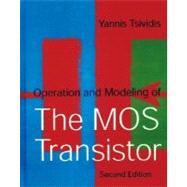
What is included with this book?
| Semiconductors, Junctions, and Mosfet Overview | |
| Introduction | |
| Semiconductors | |
| Conduction | |
| Transit Time | |
| Drift | |
| Diffusion | |
| Contact Potentials | |
| The pn Junction | |
| Overview of the MOS Transistor | |
| Basic Structure | |
| A Qualitative Description of MOS Transistor Operations | |
| A Fluid Dynamical Analog | |
| MOS Transistor Characteristics | |
| A Brief Overview of this Book | |
| The Two-Terminal MOS Structure | |
| Introduction | |
| The Flat-Band Voltage | |
| Potential Balance and Charge Balance | |
| Effect of Gate-Substance Voltage on Surface Condition | |
| Flat-Band Condition | |
| Accumulation | |
| Depletion and Inversion | |
| General Analysis | |
| Inversion | |
| General Relations and Regions of Inversion | |
| Strong Inversion | |
| Weak Inversion | |
| Moderate Inversion | |
| Small-Signal Capacitance | |
| Summary of Properties of the Regions of Inversion | |
| The Three-Terminal MOS Structure | |
| Introduction | |
| Contacting the Inversion Layer | |
| The Body Effect | |
| Regions of Inversion | |
| Approximate Limits | |
| Strong Inversion | |
| Weak Inversion | |
| Moderate Inversion | |
| A "VCB Control" Point of View | |
| Fundamentals | |
| "Pinchoff" Voltage | |
| Expressions in Terms of the "Pinchoff" Voltage | |
| The Four-Terminal MOS Transistor | |
| Introduction | |
| Transistor Regions of Operation | |
| General Charge Sheet Models | |
| Approximate Limits | |
| Simplified Charge Sheet Models | |
| Model Based on Quasi-Fermi Potentials | |
| Reasons of Inversion in Terms of Terminal Voltages | |
| Strong Inversion | |
| Complete Symmetric Strong-Inversion Model | |
| Simplified Symmetric Strong-Inversion Model | |
| Simplified, Source-Referenced, Strong-Inversion Model | |
| Model Origin Summary | |
| Weak Inversion | |
| Moderate Inversion | |
| Interpolation Models | |
| Source-Referenced vs. Body-Referenced Modeling | |
| Effective Mobility | |
| Temperature Effects | |
| Breakdown | |
| The p-Channel MOS Transistor | |
| Enhancement-Mode and Depletion-Mode Transistors | |
| Model Parameter Values, Model Accuracy, and Model Comparison References | |
| MOS Transistors and Ion-Implanted Channels | |
| Introduction | |
| Enhancement nMOS Transistors | |
| Preliminaries | |
| Charges and Threshold Voltages | |
| Drain-to-Source Current Model for Strong Inversion | |
| Simplified Model for Strong Inversion | |
| Weak Inversion | |
| Depletion nMOS Transistors | |
| The Need for an n-Type Implant | |
| Charges and Threshold Voltage | |
| Transistor Operation5.4. Enhancement pMOS Transistors | |
| Surface-Channel Enhancement-Mode pMOS | |
| Buried-Channel Enhancement-Mode pMOS | |
| Small-Dimension Effectsby D. Antoniadas, Massachuseets Institute of Technology | |
| Introduction | |
| Channel Length Modulation | |
| Barrier Lowering, Two-Dimensional Charge Sharing, and Threshold Voltage | |
| Introduction | |
| Short-Channel Devices | |
| Narrow-Channel Devices | |
| Summary and Comments | |
| Punchthrough | |
| Carrier Velocity Syndrome | |
| Hot Carrier Effects-Substrate Current, Gate Current, and Breakdown | |
| Scaling | |
| Effect of Surface and Drain Series Resistances | |
| Effects Due to Thin Oxides and High Doping | |
| The MOS Transistor in Dynamic Operation-Large-Signal Modeling | |
| Introduction | |
| Quasi-Static Operation | |
| Terminal Currents in Quasi-Static Operation | |
| Evaluation of Charges in Quasi-Static Operation | |
| Introduction | |
| Strong Inversion | |
| Moderate Inversion | |
| Weak Inversion | |
| General Charge Sheet Model | |
| Depletion | |
| Accumulation | |
| Plots of Charges versus VGS | |
| Uses of Charges in Evaluating Terminal Currents | |
| Transit Time Under DC Conditions | |
| Limitations of the Quasi-Static Model | |
| Non-Quasi-Static Modeling | |
| Introduction | |
| The Continuity Equation | |
| Non-Quasi-Static Analysis | |
| Small-Signal Modeling for Low and Medium Frequencies | |
| Introduction | |
| A Low-Frequency Small-Signal Model for the Intrinsic Part | |
| A Two-Path View | |
| Table of Contents provided by Publisher. All Rights Reserved. |
The New copy of this book will include any supplemental materials advertised. Please check the title of the book to determine if it should include any access cards, study guides, lab manuals, CDs, etc.
The Used, Rental and eBook copies of this book are not guaranteed to include any supplemental materials. Typically, only the book itself is included. This is true even if the title states it includes any access cards, study guides, lab manuals, CDs, etc.